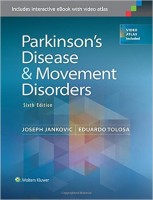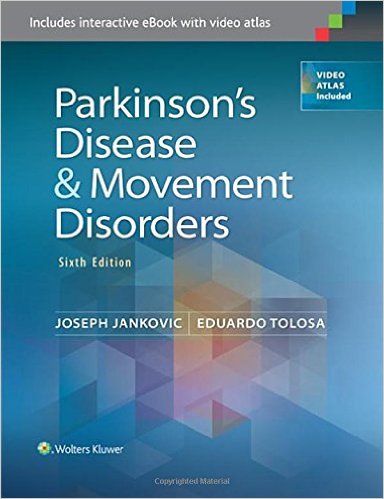 Editors: Joseph Janovic, MD and Eduardo Tolosa, MD
Editors: Joseph Janovic, MD and Eduardo Tolosa, MD
Publisher: Wolters Kluwer | Lippincott, Williams & Wilkins – 576 pages
Book Review by: Nano Khilnani
Since the first edition of this book was released 27 years ago in 1988, “extraordinary advances” have been made in the study of Parkinson’s disease and other movement disorders, Drs. Janovic and Tolosa point out in their Preface.
While these advances were discussed in four other editions between the first and the current sixth edition, the primary goal of this book you are reading is to highly and critically review all this progress.
At the early onset of Parkinson’s disease, shaking, rigidity, slowness of movement and difficulty with walking and gait take effect. But as the disease progresses, thinking and behavioral problems may arise, with dementia commonly occurring in the advanced stages of the disease, whereas depression is the most common psychiatric symptom. Other symptoms include sensory, sleep and emotional problems, as an article in Wikipedia briefly describes it.
While it is most common in those aged 50 and above, this disease does afflict younger people as well, and in such instances it is called young onset Parkinson’s disease (YOPD).
Parkinson’s is a degenerative disorder of the central nervous system (CNS) mainly affecting the motor system. The motor symptoms appear after the death of dopamine-generating cells in the substantia nigra, a region of the midbrain. Why the cells die has not yet been discovered, I suppose.
New discoveries are always being made, and many are discussed in this latest edition. More than a hundred specialists in neurology and related fields from 18 countries – Argentina, Australia, Austria, Brazil, Canada, France, Germany, Greece, Ireland, Israel, Italy, Japan, the Netherlands, Spain, Sweden, Turkey, United Kingdom, United States – contributed material to produce this volume.
This book contains 53 chapters. The range of topics is very wide. It is not only about the many aspects of Parkinson’s but also on other motor diseases. The editors point out: “functional, biochemical, and structural abnormalities of the basal ganglia, the cerebellum, and their connections are responsible for the vast majority of the disorders discussed in this volume.”
Drs. Janovic and Tolosa write a bright note: “our understanding of the mechanisms that underlie cell death and their relevance to neuro-degeneration has also improved markedly as a result of new knowledge about cell biology and genetics.” They also inform us that there is now not just a single cause of Parkinson’s disease, but multiple ones.
As a matter of fact, many researchers now write in terms of a range of “Parkinson’s diseases.” Neurodegenerative disorders are now classified according to the predominant pathologic abnormality into these distinct types:
- Synucleinopathies: Parkinson’s disease, multiple system atrophy, dementia with Lewy bodies
- Tautopathies: progressive supranuclear pals, corticobasal degeneration, frontotemporal dementia with parkinsonism
- TDP-43 proteinopathies
But new classes of neurodegenerative diseases are expected to emerge as we learn about new and unifying pathogenic mechanisms, the editors assert.
They also point out importantly that non-motor disabilities of those afflicted with neurodegenerative disorders are also becoming increasingly more recognized these days, besides the well-known dementia, depression and psychosis. Among these are:
- Sensory abnormalities (including anosmia, paresthesias, and pain)
- Autonomic dysfunction (including orthostatic hypotension, bladder, bowel, and sexual dysfunction)
- Sleep disturbances (including insomnia and rapid eye movement sleep behavior disorder)
They write that these non-motor symptoms are often resistant to levodopa therapy, which is the most effective symptomatic treatment in Parkinson’s disease.
The entire contents of the print edition are available for download as an eBook. Follow these simple steps:
- Go to http://solution.lww.com/access
- Enter the Access Code found on the inside front cover of this book
- Enter your information, click Submit, and follow the on-screen instructions to start reading your eBook
Your book purchase includes not only a complimentary download of the enhanced eBook for iOS, Android, PC and Mac, but also includes these features:
- Complete content with enhanced navigation
- Powerful search tools and smart navigation cross-links that pull results from content in the book, your notes, and even the web
- Cross-linked pages, references, and more for easy navigation
- Highlighting tool for easier reference of key content throughout the text
- Ability to take and share notes with friends and colleagues
- Quick reference tabbing to save your favorite content for future use
Among the benefits of owning this book are:
- Get comprehensive, current information on every aspect (including behavioral and psychologic concomitants) of all common and uncommon movement disorders, including Parkinson’s disease, other neurodegenerative diseases, tremors, dystonia, Tourett’s syndrome, Huntington disease, and ataxia.
- Focus on the new discoveries you need to know about: the role of ubiquitin-proteosome and autophagy systems in neurodegeneration; genetics of Parkinson’s disease and other movement disorders; innovative medical and surgical treatment of Parkinson’s disease and hyperkinetic movement disorders; and more.
- Stay up to date with new information on autoimmune disorders. Novel deliveries of drugs, and new formulations of botulinum toxin.
- Enhance your understanding through an outstanding collection of videos, including dozens new to this edition, that demonstrate what you’re likely to see in practice and key elements to look for
- View videos online with the included interactive eBook, available on your tablet or smartphone.
Editors:
Joseph Jankovic, MD is Professor Neurology, Distinguished Chair in Movement Disorders, and Director of the Parkinson’s Disease Center and Movement Disorders Clinic in the Department of Neurology at Baylor College of Medicine in Houston, Texas.
Eduardo Tolosa, MD is Professor of Neurology in the Parkinson’s Disease and Movement Disorder Unit Neurology Service at Hospital Clinic Universitari at University of Barcelona in Barcelona, Spain.







